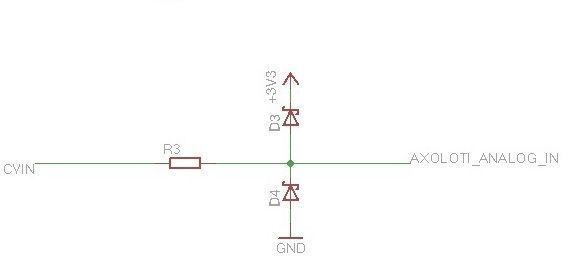do you mean like industrial radio midi bass for example? that is a nice solution (i have one) but for best results you will have to divide your frets in six parts to get a switch for every string.
Polybass copy / guitar pickup to analog in
Maybe, maybe not, there are a few different type attempts, you can get good enough monophonic results without dividing the fret. But they seem to get mixed results when wanting to use the pickup as well.
My thoughts are kind of towards, lets say for example the guitar is plugged directly into the Axo, so the guitars ground and Axo are now linked. But the guitar ground wire will have a 1k resister on it. Resister differential is added to the strings at the guitar head so the voltage is split to different levels by the resistors down each string. Each fret is connected to an analog input. So when no string is press against a fret, they are all grounded, but when the string connects to the fret, the signal follows the path of less resistance send a voltage level to the analog inputs, therefore giving a reading of fret and string. And at the same time, the audio is still going into the Axo for normal play etc..
Well its just an idea for now... 
yeah for monophonic that could work.
but an analog in per fret seems like a waste. better to go one analog in per string. then connect resitors between each fret and so you get a different reading for every fret you press down. (that's how it is done in commercial products) hmm, but multiple strings on the same fret pressed down could be an issue then...(again, what commercial products mostly use, except for frettrax, but they have no open string detection as of now, no velocity)
Do you know how I would do that? So for voltages above 3.3V i put a zener diode, what do I do for negative voltages?
according to this article (scroll down to the last bit) a single zener should suffice...
https://www.electronics-tutorials.ws/diode/diode-clipping-circuits.html
Thx!! So I guess I could use a 3.3V zener diode and a schottky diode for the negative range?
Little Update here:
I found a dual output dc converter that I hooked up to the 5v axoloti pins to generate +-9v for the GK.
Officially the GK takes 7V but seems to be working fine on 9v.
The Bass patch works great so far, although I need to work on my priority/string detection logic.
Next will be to use the pot and the swtiches on the GK to do Subbass volume and patch changes.
I measured that the pot puts out 6.5V when open. Way too much for axoloti. How would I scale this down?
I found this in the Euxoloti thread. Would it work for this application? Does anybody know which value r3 has to have for scaling down 6,5V to 3V?
I'm a real noob with this electronics stuff. So just a 3.3V zener is enough to clip all voltages to a 0-3.3V range?
In the example you send me there is still -0,7V going through, or is that dependend on the diode you use?
For 6.5V CV from the GK pot I built a simple voltage divider using two resistors. Works like a charm. I want to add diode protection here too though, just to be shure.
Hey everybody!
I was recently messing with octave down patches (my octave pedal died recently, it's a sad time for my hardware family https://sebiik.github.io/community.axoloti.com.backup/t/man-vs-midi-controller/6307/5) and found this old thread...
@Blindsmyth did you manage to make the low.note priority bass?
I made and used quite a lot a kind of BOSS oc-3 emulation using @lokki's objects, here's the patchoc-3.axp (58.1 KB)
I suspect the oc-3 works in a similar way, monophonic analogue-style octave generation for band-passed signals, instead of pitchshifter approach.
I was now trying to have it be low-note priority, and I came up with two approaches.
Here come the patches
1priority.axp (34.0 KB)
bandpriority.axp (31.3 KB)
They both kinda work, far from perfectly.
I'd love to hear what you guys think!
Cheers
UH, be careful with the noise gate threshold and the low-priority threshold, they might be set very differently with different pickups/instruments
